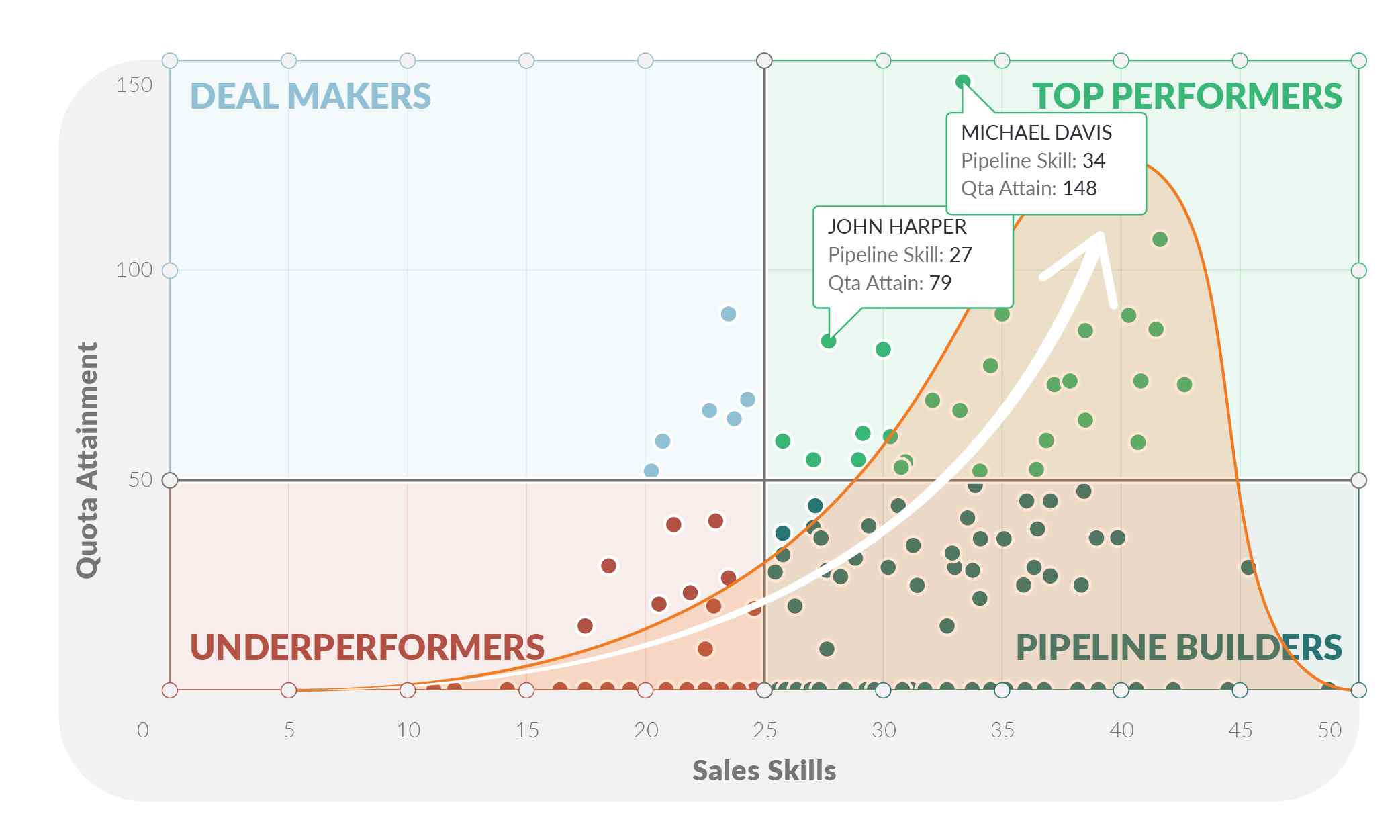
Image Source: xant.ai
As a sales leader you may have dreamt of a moment where every salesperson on your team – by whatever measure – is performing to their maximum: closing every opportunity, achieving their goals 100% of the time, all the time. However, I am 100% certain that this dream has never ever become a reality. Or if it has, it was a brief flash in the pan never to be repeated.
Now here we are, in a world where the global pandemic has led to massive changes in markets; with scarce resources, increasing competition and different ways of approaching and transacting business with ever more demanding customers.
Many markets and industries have experienced increased pressure on prices causing a sharp slowdown in income growth and lower profit margins. In many cases sales cycles are longer than they used to be with prospects delaying decisions, or not making them at all. It is fair to say that for a lot of businesses it has become more difficult to close a sale…
In such times, sales leadership styles can change for better or worse. In the economic crisis of 2008, I once heard a very senior sales leader suggest his version of the carrot and stick theory:
“If you beat the sales team with a stick and it doesn’t work, beat them with the carrot until it does!”
Now I’m not advocating that approach (it didn’t work then, and I doubt it would work now), rather I would advocate taking a positive leadership style and look at measures such as sales effectiveness to see what can be changed and how.
Here’s an excellent resource we’ve written about ‘Why emotional intelligence is important in sales’
The difference between Sales effectiveness and sales efficiency can sometimes be confusing so let’s examine these first
What is meant by “sales effectiveness?”
According to Wikipedia, Sales effectiveness refers to the ability of a company’s sales professionals to “win” at each stage of the customer’s buying process, and ultimately earn the business on the right terms and in the right time frame.
In the 360 blog on Salesforce.com, it is suggested that:
“Sales effectiveness is not about how you allocate your sales force’s resources — it’s about how potently you utilize them to achieve your goals.
If you can find a way to squeeze in 20 additional prospecting phone calls for your reps each week, then you’ve accomplished the aforementioned feat of improved efficiency.
How skilled your reps are at executing those phone calls is a sure measure of their effectiveness. A more effective salesperson might produce ten qualified opportunities from those 20 calls, while a less effective seller might only create five.
More effective salespeople will yield a higher output from the same level of effort because they just do the task better. Sample metrics of effectiveness might be ‘deal win rate’ or ‘percentage of successful sales calls.’
Someone once described the distinction between efficiency and effectiveness in this way:
Efficiency is about knocking on as many doors as possible; Effectiveness is about what you do when the doors open. You could call it a dichotomy of ‘Will versus Skill’ or ‘Brawn versus Brain,’ but the important thing is to understand that there are two different forces at work that influence the productivity of your sales team.”
The importance of measuring the performance of a sales team on an ongoing basis cannot be underestimated. In many cases, the success of a sales team is a barometer for the success of the business itself. As a result, and in line with the above, knowing how to measure sales effectiveness is key.
If you understand the customer’s buying cycle, you can ensure your sales cycle is aligned to it. However, if you don’t understand which members of your sales team are doing well and where in that cycle, or which are doing poorly and why, how can you make the adjustments necessary to improve things?
Below are some suggestions for parameters that you can incorporate into your dashboard as measures of sales effectiveness:
1. Sales Revenue
An obvious place to start, right?
The majority of sales organisations will have sales targets – whether that’s revenue, profit margin, number of units or a combination of these and other metrics. In principle if sales revenues/profits/units are rising then things are going well.
However, such metrics are very high-level, and don’t tell the whole story of what’s really happening. The reality is that many other variables are at play and when a sales leader just rewards and reprimands based on sales revenue/profits/number of units measures, employee turnover and development can be impacted.
Here’s a great interview between our own Sales Professor Ramez Helou and the legendary Brian Tracey where they discuss ‘minimum standards’ for growing sales.
2. Activity Levels
A focus on activity levels can be useful when determining how to measure sales effectiveness.
In the Salesforce.com example of squeezing in 20 extra calls per week this is certainly increasing sales efficiency. However, as per this example, how effective are these calls?
One way to measure this would be to look at conversion ratios. In the first example, the salesperson did 20 calls and got 10 qualified opportunities – a ratio of 2:1.
In the second example the ratio is 20 calls to 5 qualified opportunities or 4:1.
By that measure the first sales person is more effective than the second.
The real question is why?
- What is the difference between the two salespeople’s approach to the calls?
- Are there differences in skill levels?
- Is there any difference between the prospects that are being called? Different geographies, or different market sectors for instance?
- Are there any trends apparent here – have the ratios changed over time?
- How well “qualified” are the resulting opportunities – are we comparing apples with apples?
These ratios represent a useful insight, and should be factored in as a measure of sales effectiveness. However, I hope you can see that activity levels shouldn’t be used without an understanding of why they are what they are.
3. Hours Worked
In my own successful sales career, I had a period lasting more than 15 years during which I became a “sales nomad”. I was able to work from any location (a company office, a client’s location, a hotel, a train, a channel partner office or from home).
On rare occasions I would work for 24 to 48 hours straight if I was working on a large proposal, and I would often remotely log in to the office systems at weekends or late in the evening to get things done.
However, if I worked 20, 40, 60 or 80 hours in a week should that really be measured?
From my perspective, I often worked very long hours because I had a job to do, and I reaped the rewards for my success. However, sometimes I would want a modicum of work-life balance to spend time with my wife and children.
Interestingly, for a lot of businesses the pandemic has created opportunities for home working that did not exist previously for many employees (sales included).
Organisations have had no choice but to adopt video conferencing technologies from companies such as Zoom, Microsoft Teams and Google Meet to continue to do business.
Whilst this might have changed the sales and buyer dynamics from a communications perspective, a plus is that salespeople are not having to spend as much time travelling between appointments.
How is this saved time being used?
In good times, and if a salesperson is blasting through their numbers, the actual hours worked aren’t really an issue.
Conversely, when a salesperson is struggling, one of the first questions asked by sales management is: “is he or she putting the hours in?”
A way of measuring this might be monitoring when a salesperson was accessing company systems. Alternatively checking their calendar or sales reports for field-based salespeople to see when they are with customers and prospects (face to face or on Zoom).
I’d recommend being careful with this approach as it can come across as “big brother” and affect the morale of salespeople. As a measure, hours worked can be used but with caution.
However, sometimes sales teams need help with overcoming procrastination, here’s an excellent blog on this topic
4. Productivity
One measure of productivity is to divide activity by the hours worked.
This obviously depends upon what your measure of ‘activity’ is… But it can be an important factor in measuring sales effectiveness because it shows you if the resource is efficient and working hard.
High activity levels can be a good thing. However, is the activity in the right area? Is it generating qualified pipelines and moving deals through the sales cycle?
Or is the salesperson having lots of meetings with prospects but never coming away with an order because they don’t know how to close, or too scared to ask the prospect for a commitment?
5. Sales Messaging
You will have gathered by now that simply looking at how hard and how much a salesperson is working isn’t enough on its own. A key metric has to be how good (effective) are they at delivering the right sales message?
Is the salesperson building rapport with the prospect? Are they asking the right questions and identifying the prospects’ needs? Are they correctly qualifying the opportunity (timescale, budget, decision maker etc.), and are they delivering the right message at the appropriate points to the right people?
If the messaging or their delivery is incorrect, then the odds are that they will walk away from the prospect empty handed.
How do you measure this?
One way is to practice in the office so that improvements and tweaks can be made there rather than in front of the prospect. Different aspects of the sales process can be checked through role plays, the development of scripts and so on.
Another way is for sales management and leaders to participate in sales meetings with the salesperson.
By participating, an experienced sales manager can give positive and constructive feedback that will help the salesperson learn and improve.
6. Tactics and Techniques
Any good sales training program will provide the correct tactics and techniques that the sales team can use in front of prospects and clients. As a measure of sales effectiveness, the question should be asked as to whether the salesperson is using the training they’ve been given or not?
However, once again these cannot be taken in isolation.
If the tactics and techniques are not aligned to the company’s messaging, they won’t be effective.
Equally, if the salesperson is trying to close when the prospect is still qualifying whether the product or service is suitable for their business… you get the idea.
So, to summarize
- Understand the difference between sales efficiency and sales effectiveness
- How to measure sales effectiveness should include the following elements:
- Sales revenue
- Activity levels
- Hours worked
- Productivity
- Sales messaging
- Tactics and techniques
Would you like help in terms of how to measure sales effectiveness, increase sales revenue and profitability for your business?
If yes, schedule a complimentary consultation with one of our learning and development specialists today.

Alan Bell
Want to receive more great sales strategies directly in your inbox? Complete the form to receive future content by email

Recent Comments